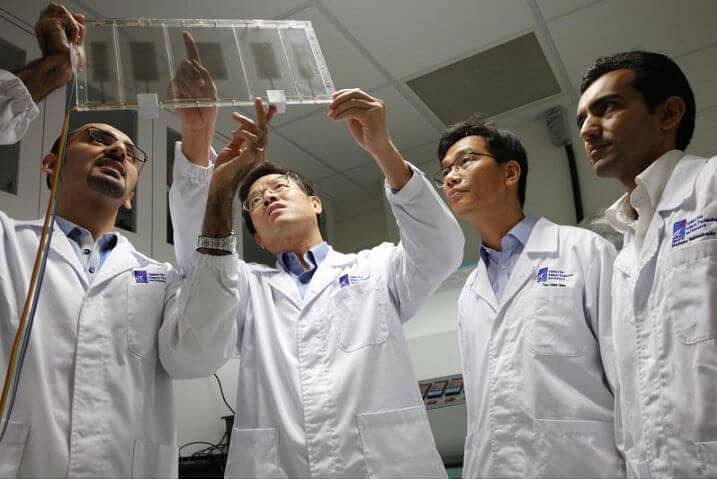Scientists create film for windows that blocks noise and plays music
Sign up now: Get ST's newsletters delivered to your inbox

(From left) Meysam Sharifzadeh Mirshekarloo, Dr Yao Kui, Dr Tan Chin Yaw and Mojtaba Rahimabady are the team at A*Star which is currently developing transparent piezoelectric speakers.
ST PHOTO: DON WONG
Lin Yangchen
Follow topic:
SINGAPORE - A laboratory in one of Singapore's most high-tech precincts is the last place you would expect to be serenaded by the great Austrian conductor Herbert von Karajan and the Berlin Philharmonic.
Yet on Tuesday (June 27), a recording of Richard Strauss' Don Juan was playing when The Straits Times visited the hideout of a team of scientists.
The restricted third-floor room in Fusionopolis is cramped with machines festooned with dials and knobs with wires snaking in all directions.
The team is led by 49-year-old Dr Yao Kui from the Agency for Science, Technology and Research's (A*Star) Institute of Materials Research and Engineering.
They have been working on a window-mounted sheet of transparent film that plays music and blocks unwanted noise.
It is the gestating fruit of a collaboration between A*Star, the Housing Board (HDB) and the National Environment Agency.
HDB said noise is a common problem in city environments and it works with academics and the private sector to find ways of using technology to enhance residents' quality of life in housing estates.
HDB added that if the technology looks promising from both the technical and financial standpoints, it may study the possibility of implementing it on a wider scale.
Unlike regular speakers, which are set in motion by electromagnets, the A*Star contraption is piezoelectric - it moves in response to changes in electrical voltage.
Made of a polymer strengthened with transparent lamination, its powers go beyond making music: it also cuts out unwanted noise, using the same principle as noise-cancelling headphones.
Sound consists of waves that oscillate rapidly between low and high pressure.
A signal processor measures these waves 50,000 times a second, analyses them automatically, and commands the speakers to produce similar waves but with one crucial difference.
The high-pressure parts of the speaker's waves coincide with the low-pressure parts of the noise and vice versa, a process that does what it is called - destructive interference.
Yet the real breakthrough in the scientists' work is not this.
It is the use of two layers of windows with openings in staggered positions, channelling noise from outside through a short passageway between the layers, where it is "destroyed" by the speakers lining the windows before it can get into the room.
This allows the windows to be kept open in the tropical climate.
About 10 years ago other scientists worked on noise-cancelling windows, but the windows had to be shut to work.
Microphones at both the external and internal openings of A*Star's double-layered window feed noise data into the signal processor to enable it to make its calculations.
Dr Yao is helped by colleagues from A*Star's Institute of High Performance Computing, who run computer simulations of the system. "From the simulation we can tell theoretically what is the optimal configuration," he said.
But it is not quite there yet if you are thinking of bringing the house down with heavy bass and surround sound. The speakers do crackle and cannot be throttled up beyond the volume of background music without clipping.
Dr Yao, however, said the team's focus at the moment is not on sound quality, and that there is potential for achieving higher-fidelity sound in combination with the kind of technology already found in some flat-screen televisions with thin-film speakers.
Dr Yao pointed out that the noise-busting musical window is only at the beginning of a long journey.
"There are many factors to consider besides the technology. For example, it is more complicated than a normal window - are people willing to accept that in their homes," he said.

